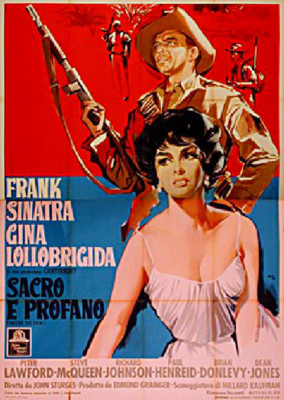| Reviews & Columns |
|
Reviews DVD TV on DVD Blu-ray 4K UHD International DVDs In Theaters Reviews by Studio Video Games Features Collector Series DVDs Easter Egg Database Interviews DVD Talk Radio Feature Articles Columns Anime Talk DVD Savant Horror DVDs The M.O.D. Squad Art House HD Talk Silent DVD
|
DVD Talk Forum |
|
|
| Resources |
|
DVD Price Search Customer Service #'s RCE Info Links |
|
Columns
|
|
|
Never So Few
He and Sturges would work together again on The Magnificent Seven (1960) and The Great Escape (1963). Sturges probably looked back on Never So Few as an example of how not to make a war movie. None of the many qualities of The Great Escape are present in Never So Few except McQueen. At one point McQueen even wears a gray sweatshirt with the sleeves cut short, just as would later in Great Escape.
OSS Captain Tom Reynolds (Sinatra) has been fighting in the jungle without a proper surgeon or even morphine for months. After a skirmish with some Japanese, he's forced to mercy-kill his loyal Kachin aide, Bye Ya (Guy Lee) after the young man is shot in the belly. This shocks Reynolds's experienced British second-in-command, Capt. Danny De Mortimer (Richard Johnson). The two men fly to Calcutta demanding proper medical support from commanding officer Co. Fred Parkson (Robert Bray). While there, Parkson introduces them to rich but dodgy merchant Nikko Regas (Paul Henreid), his dodginess leading nowhere, and his opportunist girlfriend, Carla Vesari (Lollobridgida). Tom makes a play for Carla but she's not interested; he can't provide for her as Nikko can.
Danny falls ill with malaria, forcing an extended stay at Nikko's mansion, where Carla begins to warm to Tom's charms, or at least his persistence. Meanwhile, he conscripts Danny's doctor, Capt. Grey Travis (Peter Lawford), and his good-in-a-fight driver, Corporal Bill Ringa (Steve McQueen).
Never So Few is all over the map, literally and figuratively. The location footage, shot mostly in Thailand but apparently also in what was then Ceylon (now Sri Lanka), is exotic and colorful, particularly by 1959 standards when for most Americans a short trip to London or Paris was considered highly adventurous. The unspoiled scenery and famous landmarks would look a lot different in a few years: many of the Thai scenes were shot in the same vicinity as scenes filmed for The Man with the Golden Gun and it sure looked different by 1973-74. That said, the lion's share of this MGM release was filmed on soundstages at MGM, including nearly all the jungle scenes.
Integral to The Great Escape but notably absent here is any sense of verisimilitude. Sinatra is never believable as an OSS captain, though it's not a bad performance. He looks faintly ridiculous in the opening scenes, sporting a goatee (which mysterious vanishes later), an unconvincing hairpiece, and a goofy, African safari-type hat. Richard Johnson, a superb actor in the right role, plays his clichéd British cohort, complete with monocle and what one imagines to be a fencing scar. Other members of the unit are genre stereotypes: Dean Jones and Charles Bronson play a rich, carefree goof-off and Lakota code talker, respectively, who constantly fight because thin-skinned Bronson doesn't like Jones calling him "Hiawatha." Bronson is particularly wasted on a potentially interesting character, yet except for a brief perfunctory scene of Bronson code-talking he has little to do.
Except for McQueen. The ambitious actor knew, good or bad, this was a Big Movie where he could get a lot of exposure, and maximizes every moment the camera is on him. I recently caught an old interview with Great Escape co-star James Garner who confessed he didn't think much of McQueen as an actor ("You could always see him acting," he said), but couldn't deny McQueen had a quality that made audiences want to watch him. In a sense that's truer in a mediocre film like Never So Few than his famous starring films. If McQueen's in the frame, it doesn't matter if he's sharing the screen with Sinatra, Bronson, Lollobridgida or anyone else: your eyes can't help but focus on him.
More than anything else, it's the sappy romance, weakly written and lacking chemistry, that kills Never So Few. It takes away from the male-bonding, Zulu-like impossible odds stuff the movie's advertising promises, nice as it is to see Lollobridgida semi-nude in a bathtub. Toward the end, Never So Few's story turns political, vaguely alluding to Cold War tensions between the U.S. and China. This material comes out of nowhere, and curiously moves the plot indoors without a big climatic battle, though Brian Donlevy has several good moments with Sinatra as a sympathetic general.
Video & Audio
Advertised in CinemaScope but actually filmed in Panavision, Never So Few looks good for the most part on Blu-ray, the rich colors coming off a bit better than the image, which is a trifle soft in long shots as if overwhelmed by the jungle foliage. The robust DTS-HD Master Audio 5.1 stereo surround helps the battle scenes measurably, and English subtitles are offered.
Extra Features
A trailer and that's it.
Parting Thoughts
Not good but worth seeing for its cast and colorful Asian locations, Never So Few is Recommended.
Stuart Galbraith IV is the Kyoto-based film historian largely absent from reviewing these days while he restores a 200-year-old Japanese farmhouse.
|
| Popular Reviews |
| Sponsored Links |
|
|
| Sponsored Links |
|
|
| Release List | Reviews | Shop | Newsletter | Forum | DVD Giveaways | Blu-Ray | Advertise |
|
Copyright 2024 DVDTalk.com All Rights Reserved. Legal Info, Privacy Policy, Terms of Use,
Manage Preferences,
Your Privacy Choices | |||||||















